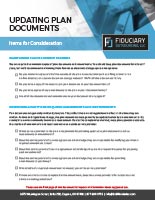#1 Not Updating Plan Documentation

The Story
When Valorum Veterinary Services created their 401(k) plan, they elected to use a 7 year graded vesting schedule. In 2006, Congress removed the ability to have a 7 year graded vesting schedule on matching and profit sharing monies. The longest vesting schedule allowable became a 6 year graded vesting schedule.
Valorum relied on NMR Recordkeeping to maintain their plan document and provide required amendments. While updating Valorum’s plan for the law change, NMR failed to provide an amendment that included switching the vesting schedule. The issue was discovered in 2015 when the plan’s new financial advisor asked about plan provisions while preparing for an employee education meeting.
Who is Responsible?
NMRR’s service agreement did state that they agreed provide all documents and amendments. However, it specifically stated that Valorum agreed to have all plan documents and amendments reviewed by legal counsel, or an outside consultant familiar with retirement plans, before any documents were signed. NMR’s service agreement further stated they had no responsibility for the plan amendments they prepared. In other words, NMR had no liability for failing to provide amendments to change the vesting.
How did they fix it?
Valorum decided to hire an ERISA attorney whose recommendation was to:
- Amend the plan’s vesting provisions retroactively to January 1, 2007 to use the six-year graded schedule.
- Sign the amendment current day.
- Submit the amendment along with a VCP submission to the IRS for approval to retroactively amend the plan.
Valorum agreed to their attorney’s recommendation. Six weeks later, the plan received a letter from IRS that the VCP submission was approved and the plan was back in compliance.
How did they keep it from happening again?
While Valorum was relieved that the identified problem was revolved, they were concerned it might happen again. They spoke to their ERISA attorney who was willing to review all plan amendments, but Valorum would still be the responsible fiduciary. Valorum decided to outsource plan document oversight to Fiduciary Outsourcing who acts as the responsible plan fiduciary for all plan documents and amendments.

The Mistake
Every 401(k) plan has a legal plan document. It details exactly how the plan is supposed to be operated.
It includes items such as:
- When an employee first becomes eligible for the plan
- What compensation is to be used to figure out contributions
- What contributions can be made
- How to determine who gets a contribution
- When employees can be paid out of the plan
- How much the employees can withdraw
A summary of the long legal plan document, called a Summary Plan Description, is provided to employees so they know how the plan works.
Think of the plan document as a contract between the business and the employees. The business agrees to provide certain benefits at certain times. The employees have the right to receive the benefits provided by the business.
The plan document also includes the legal wording required by Congress, the IRS and the DOL that provides much of the fine detail of exactly how the plan should operate. From time to time, the government updates the rules. As a result, they require businesses to update their plan documents to reflect the updated rules. These are referred to as required amendments.
From time to time, the business may want to change how the plan works. For example, Beta Bread, Inc. has historically made new employees wait 6 months before they could enter the plan. Beta wants to be more generous and allow employees to enter the plan after only 3 months. While that change is perfectly legal and acceptable, the plan document must change within certain government mandated timeframes in order to the plan document to be considered timely updated. These are referred to as voluntary amendments.
There are different timing rules for required and voluntary amendments. In addition, some voluntary amendments can only be effective prospectively.
The failure to update the plan documents occurs when either a required amendment or a voluntary amendment is not done within the proscribed timeframe.

What Happens
The IRS allows for retroactive amendment of plans for required amendments. It is also possible to retroactively amend plans for some voluntary amendments, but the voluntary amendment usually can’t take something away retroactively.
The hitch is, you can’t simply retroactively adopt the amendment and move forward. The IRS requires retroactive amendments be submitted to them for approval through their Voluntary Correction Program or VCP. There is a user fee for getting the approval and several forms that need to be completed. The forms state that you forgot to do the amendment, ask permission to retroactively amend, and tell the IRS how you changed your procedures to ensure you won’t make the same mistake again. The user fee varies based on the number of participants in the plan. If you submit a retroactive amendment, you will almost always get the IRS to approve the amendment adoption. They may make you adjust the amendment language, but they will almost always approve the retroactive amendment. Problem solved!
Avoid it
In order to avoid failing to amend a plan for a required law change, first determine which of the plan’s current service provider team is responsible for maintaining your plan documents. Confirm with the service provider that they have procedures in place to ensure the timely delivery of required amendments. You should have a procedure in place to ensure that required amendments are timely adopted and stored with the plan’s record for future reference.
With regard to voluntary amendments, it is important to understand what plan provisions are contained in the plan document. Any change to provisions contained in the plan document require an amendment. A Best practice would be to consult with the service provider responsible for providing you with plan amendments before making any changes to the way the plan operates.
If you have any questions or concerns with regard to a required or voluntary amendment, you can retain ERISA counsel to assist you in maintaining these records. Alternatively, it is possible to outsource the responsibility for maintaining plan documents to a professional fiduciary administrator.

How We Help
You have the ability to outsource your responsibilities as the Plan Administrator. As such, you can outsource the responsibility for maintaining plan documents to us. We then assume a fiduciary responsibility to the plan for maintaining plan documents.
We can determine when required plan amendments are needed. We can keep track of discretionary amendments if you or one of your service providers informs us of the intention to amend the plan. We will confirm that the sponsor has agreed to adopt the amendment in the format we presented to you. Once we have confirmation that your board or management team has approved the amendment, we execute the amendment on your behalf. We also retain records of all plan amendments in the event of a lawsuit or audit.

The Story
When Valorum Veterinary Services created their 401(k) plan, they elected to use a 7 year graded vesting schedule. In 2006, Congress removed the ability to have a 7 year graded vesting schedule on matching and profit sharing monies. The longest vesting schedule allowable became a 6 year graded vesting schedule.
Valorum relied on NMR Recordkeeping to maintain their plan document and provide required amendments. While updating Valorum’s plan for the law change, NMR failed to provide an amendment that included switching the vesting schedule. The issue was discovered in 2015 when the plan’s new financial advisor asked about plan provisions while preparing for an employee education meeting.
Who is Responsible?
NMRR’s service agreement did state that they agreed provide all documents and amendments. However, it specifically stated that Valorum agreed to have all plan documents and amendments reviewed by legal counsel, or an outside consultant familiar with retirement plans, before any documents were signed. NMR’s service agreement further stated they had no responsibility for the plan amendments they prepared. In other words, NMR had no liability for failing to provide amendments to change the vesting.
How did they fix it?
Valorum decided to hire an ERISA attorney whose recommendation was to:
- Amend the plan’s vesting provisions retroactively to January 1, 2007 to use the six-year graded schedule.
- Sign the amendment current day.
- Submit the amendment along with a VCP submission to the IRS for approval to retroactively amend the plan.
Valorum agreed to their attorney’s recommendation. Six weeks later, the plan received a letter from IRS that the VCP submission was approved and the plan was back in compliance.
How did they keep it from happening again?
While Valorum was relieved that the identified problem was revolved, they were concerned it might happen again. They spoke to their ERISA attorney who was willing to review all plan amendments, but Valorum would still be the responsible fiduciary. Valorum decided to outsource plan document oversight to Fiduciary Outsourcing who acts as the responsible plan fiduciary for all plan documents and amendments.

The Mistake
Every 401(k) plan has a legal plan document. It details exactly how the plan is supposed to be operated.
It includes items such as:
- When an employee first becomes eligible for the plan
- What compensation is to be used to figure out contributions
- What contributions can be made
- How to determine who gets a contribution
- When employees can be paid out of the plan
- How much the employees can withdraw
A summary of the long legal plan document, called a Summary Plan Description, is provided to employees so they know how the plan works.
Think of the plan document as a contract between the business and the employees. The business agrees to provide certain benefits at certain times. The employees have the right to receive the benefits provided by the business.
The plan document also includes the legal wording required by Congress, the IRS and the DOL that provides much of the fine detail of exactly how the plan should operate. From time to time, the government updates the rules. As a result, they require businesses to update their plan documents to reflect the updated rules. These are referred to as required amendments.
From time to time, the business may want to change how the plan works. For example, Beta Bread, Inc. has historically made new employees wait 6 months before they could enter the plan. Beta wants to be more generous and allow employees to enter the plan after only 3 months. While that change is perfectly legal and acceptable, the plan document must change within certain government mandated timeframes in order to the plan document to be considered timely updated. These are referred to as voluntary amendments.
There are different timing rules for required and voluntary amendments. In addition, some voluntary amendments can only be effective prospectively.
The failure to update the plan documents occurs when either a required amendment or a voluntary amendment is not done within the proscribed timeframe.

What Happens
The IRS allows for retroactive amendment of plans for required amendments. It is also possible to retroactively amend plans for some voluntary amendments, but the voluntary amendment usually can’t take something away retroactively.
The hitch is, you can’t simply retroactively adopt the amendment and move forward. The IRS requires retroactive amendments be submitted to them for approval through their Voluntary Correction Program or VCP. There is a user fee for getting the approval and several forms that need to be completed. The forms state that you forgot to do the amendment, ask permission to retroactively amend, and tell the IRS how you changed your procedures to ensure you won’t make the same mistake again. The user fee varies based on the number of participants in the plan. If you submit a retroactive amendment, you will almost always get the IRS to approve the amendment adoption. They may make you adjust the amendment language, but they will almost always approve the retroactive amendment. Problem solved!
Avoid it
In order to avoid failing to amend a plan for a required law change, first determine which of the plan’s current service provider team is responsible for maintaining your plan documents. Confirm with the service provider that they have procedures in place to ensure the timely delivery of required amendments. You should have a procedure in place to ensure that required amendments are timely adopted and stored with the plan’s record for future reference.
With regard to voluntary amendments, it is important to understand what plan provisions are contained in the plan document. Any change to provisions contained in the plan document require an amendment. A Best practice would be to consult with the service provider responsible for providing you with plan amendments before making any changes to the way the plan operates.
If you have any questions or concerns with regard to a required or voluntary amendment, you can retain ERISA counsel to assist you in maintaining these records. Alternatively, it is possible to outsource the responsibility for maintaining plan documents to a professional fiduciary administrator.

How We Help
You have the ability to outsource your responsibilities as the Plan Administrator. As such, you can outsource the responsibility for maintaining plan documents to us. We then assume a fiduciary responsibility to the plan for maintaining plan documents.
We can determine when required plan amendments are needed. We can keep track of discretionary amendments if you or one of your service providers informs us of the intention to amend the plan. We will confirm that the sponsor has agreed to adopt the amendment in the format we presented to you. Once we have confirmation that your board or management team has approved the amendment, we execute the amendment on your behalf. We also retain records of all plan amendments in the event of a lawsuit or audit.

